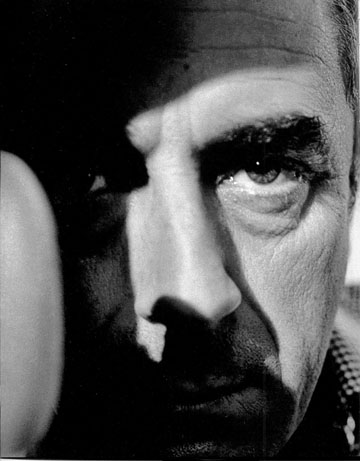“This is the centenary year of Michelangelo Antonioni,” begins the Guardian‘s Peter Bradshaw at the top of his longish, personal overview of the oeuvre, and indeed, despite his central argument—that this “remarkable director has become a bit unfashionable”—many have actually spent much of 2012 marking this 100th anniversary. In March, an international conference, part of a larger event, Homage to Michelangelo Antonioni (1912-2007), was held at NYU, and when, in May, the seven hours of the proceedings went online, Catherine Grant placed the video at the top of one of her amazing roundups. It is very much “a rather fabulous list of links” to “online and openly accessible studies of Antonioni’s work,” and it would take longer than the weekend to exhaust those resources. Still, I do recommend it as a bookmark to return to again and again.
Many will remember the shock of July 30, 2007. Ingmar Bergman passed away that morning, and Antonioni followed just hours later. The dual blow sparked a round of rumination on an era of cinema history that had, by then, long passed, an era on our minds again this first weekend of the New York Film Festival, whose 50th anniversary has prompted a few nods here and there to the culture of the early 1960s from which the first edition of the NYFF sprang. I’ve been pleasantly surprised to find that many of the links I gathered that summer of 2007 at GreenCine Daily are still live. Let me point to a few from the first entry on Antonioni (in order of appearance): Glenn Kenny (an entry that followed the excellent “Thirteen Ways of Looking at Ingmar Bergman“), Dennis Cozzalio, Scott Macaulay, A.O. Scott, Dennis Lim, Wim Wenders, Brandon Harris, Steven Shaviro, Peter Steinfels, Tom Sutpen, Richard Corliss, Chris Stangl, Jim Emerson; and from the second entry, posted a week later, J. Hoberman, David Bordwell, and Martin Scorsese.
To return to Peter Bradshaw for a moment, he, like most, regards L’Avventura (1960) as the pivotal film in Antonioni’s body of work and, like many, in the evolution of cinema itself. The day it was booed in Cannes is “as pretty much important as the audience riots at the 1913 premiere of Stravinsky’s Rite of Spring…. This was movie-modernism’s difficult birth.” Let me refer you again to Robert Koehler‘s marvelous piece on L’Avventura for Sight & Sound.
Bradshaw then moves on to the films that followed, and if he leaves you itching for a proper defense of Blow-Up (1966), there are many, of course, but probably none as fun as Peter Labuza and Glenn Kenny‘s discussion of the film from just a couple of months ago. Bradshaw then turns to the films that came before L’Avventura, two of which you can watch here at Fandor. “[I]t is a really thrilling experience to return to the almost-forgotten prehistory of Antonioni, those punchy, cerebral but often highly experimental realist pictures of the 1950s, beginning with the Greeneian, downbeat Story of a Love Affair (1950), about a forbidden relationship rekindled by the snoopings of a private detective. The film precedes by one year the publication of Greene’s The End of the Affair and in its seediness resembles Patrick Hamilton’s Gorse novels, or Gerald Kersh’s Night and the City.”
And Il grido (The Cry, 1957) “shows Antonioni beginning to morph into the famous creator of the later movies…. Here is where the existential fume of Antonioni’s work begins to be distilled: from the bones of plot arises the smoke of anxiety, disenchantment, alienation—but also a numbed kind of rapture and release at human helplessness.”
More to look at today: Mike Fleisch (HiLoBrow), Peter Nellhaus, and This Must Be the Place.
Updates: “His fundamental subject,” writes the New Yorker‘s Richard Brody, “is the bourgeoisie and the way that new methods of communication—mainly the mass media, but also the abstractions of high-tech industry, architecture, music, politics, and even fashion—have a feedback effect on the educated, white-collar thinkers who create them. These new ideas have as strong an effect on their creators and implementors as on the world around them, and knocks them off the course of their own lives. Antonioni is also one of the cinema’s great pictorialists—his images reflect, with a cold enticement, the abstractions that fascinated him. That’s why the word most commonly used to describe his view of the modern world—’alienation’—is, rather, a common mistake.”
The current issue of Cinemascope (the Italian journal, not Cinema Scope, the Canadian one): “Antonioni and the Mystery of Reality.”
Update, 10/7: The Mysteries of Michelangelo Antonioni, “an extensive retrospective of the feature-length and short masterworks,” is on at the Harvard Film Archive through November 18.
For news and tips throughout the day every day, follow @KeyframeDaily on Twitter and/or the RSS feed. Get Keyframe Daily in your inbox by signing in at fandor.com/daily.




